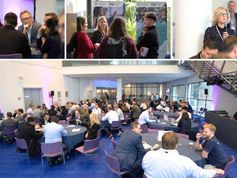Companies that adopt circular models make more money
Marcel den Hollander is the first industrial designer with a PhD in Circular Design. Now a consultant, researcher and Professor of Circular Design and Manufacturing at the Rotterdam University of Applied Science in the Netherlands.

Marcel is an industrial designer by training and has been working in commercial industrial design for over 30 years. For 13 years he has researched how companies can design sustainable products that are suited to circular business models. Here, he shares with SI.com some tips about designing and developing for the circular economy, underlining the importance of creating strong value propositions over time to help industry transition to ways of generating profits that do not rely solely on the relentless consumption of virgin materials.
“In my approach, the central aim is to preserve the added value placed in products during manufacturing for as long as possible. For as long as products or materials are valued, they will not disappear as waste out of the economic system as waste. This helps limit the influx of resources into our economic system as resources that do not escape from the economic system, do not have the be replenished with virgin resources."
The approach is twofold:
Design products that can last a long time and
Design and encourage business model contexts that allow these products to function well in them for a long time
The second is actually the most difficult. We know how to engineer products that can last a long time, but the vast majority of companies still operate in what I dubbed a ‘sell more, sell faster’ business model archetype that, since it’s inception over 200 years ago, has been encouraging consumerism. Cheap manufacture, highest selling price, and repeat. Sales volume determines revenue. It is not hard to imaging that long life products do not sit well in that paradigm.
What must happen is that we design long-life products and the business models that can profit from long-life product in conjunction, enabling companies to make sustainable profits from sustainable products.
What proportion of consumer goods companies are moving to the circular economy model?
Research shows that well over 90% of companies that manufacture physical products operate in the ‘sell more, sell faster’ business model archetype based on selling as much as you can in a time period. This is worryingly high.
Companies are trying to change but it is both very difficult and very slow. Only few companies manage to make the switch and where they do, it’s often a handful of products and for a selected group of customers only.
Many companies are trying to make their operations more circular, however it is not yet the majority. I think this will change in the future. New laws, rules and regulatory frameworks, such as those introduced by the EU, are putting increased pressure on companies to do this. Recently we, for example, saw the introduction of the ban on single use plastics and the price of CO2e emissions rights go above EU100.
I believe that it is better for companies to look ahead and pro-actively innovate before they are forced to change. With the recent ban of single-use plastics, many companies were seen scrambling to find packaging alternatives close to the ban, rather than months or years before. Changes like this can really affect a company’s position in the market and even worse, it can catch them out.
If you look for examples of companies whose products were single use and throwaway to more circular versions of themselves, it is not always easy to find good examples.
Case studies
In the Netherlands, Swapfiets is a monthly subscription bicycle service with maintenance and repair included, that replaces bike ownership. The tyres are not sold to Swapfiets, but they are supplied by the manufacturer, for a fee, and then returned to them when they need replacing, avoiding tyre waste.
Another company is Dutch electronics manufacturer Fairphone, which has redesigned the normally hard to open repair smartphone so that it can be easily opened and repaired by its owner. Generally, in consumer goods and fashion and textiles, it is difficult to find companies that switched successfully from linear to circular.
Gaining circularity
Examples of companies you have helped to do business in a more circular way
One example is Grolsch, the Dutch brewery firm. Grolsch wanted to move away from the disposable plastic shrink wrap used for their six-pack cans to a more sustainable solution. We looked at the options available that were scalable and could be mass produced within months, not years. But it is not only about the product. We, for example, also had to consider the recycling systems prevalent in the countries were Grolsch exports. After extensive and careful lifecycle impact calculations, we determined the best solution for making the switch. A solution that really reduced their eco-footprint whilst protecting their revenues. They now use a die-cut cardboard six-pack holder. An additional advantage with a sheet, cut-out and folded solution like this, as compared to injection mounded clips, is that should a new, more eco-friendly material become available in sheet form, Grolsch can retain and use the same tooling rather than having to invest in new, expensive injection moulds.
Another example is Dunlop Protective Footwear, a company that manufacturers boots in plastics like PVC and PUR. Whilst these materials are not inherently eco-friendly, they possess unique properties that are needed in professional protective footwear, such as flexibility, waterproofness and traction on potentially slippery surfaces. For lack of suitable alternatives, PVC and PUR cannot be abandoned at this point in time. We worked with them and, leveraging their knowledge, helped them identify ways and approaches to reduce their environmental footprint. Recently Dunlop launched two new product lines. One with 30% recycled materials in their PVC boots, the other with 30% of biobased material, both reducing the volume of non-renewable virgin material needed.
The lesson here is that it even when it is very difficult, seemingly impossible even, to move to ‘net zero’ in one go, it is important to make a commitment and set a goal. After that it is all about not letting go and making step by stap improvements toward that goal.
Simple solutions can work. At Dunlop we found out that in agricultural settings sometimes one boot would rip or break but had to be replaced by a new pair, discarding one good boot. We suggested that they could change their system so replacement could be purchased as single boots, not as a pair. This would only require a change in logistics not in production, but it could potentially reduce waste because of this type of damage by nearly 50%.
A big learning here is to work closer with people in your company, their intimate knowledge of what happens in the field is often where the simple answers lie.
Advantages and benefits
Costs and supply chain
Moving towards a circular supply chain has many benefits. One is that by remanufacturing products companies reduce their supply chain risk, by reducing virgin material usage and retaining control of materials. By claiming product and value back from what you make, you build a closed loop supply chain. This means you always have access to the right grade and quality, if not the quantity, of materials you need for production.
Regulations on circular economy
An advantage of moving to the circular model is that companies become more prepared for the growing environmental regulations affecting businesses. These control types of material use, the provenance, how they are processed, reused and sold, and the implications for the environment of your activities (for example the Environment Act 2021). If companies are not prepared in advance, they may have to increase their product prices just to comply with regulations, potentially risking their competitive advantage.
Conversely, if you have been integrating more circular thinking into your products before now, you can save costs and benefit from the new regulatory frameworks on a country and global level.
Profits
Marcel’s PhD research has revealed several companies that made higher profits after taking a circular business approach. Every business he interviewed said that making products from non-virgin materials – by reuse, recycling or remanufacture – made more money and, at the same time, helped cut carbon.
A good example is Dutch furniture manufacturing company Gispen. (Not one of Marcel’s clients). They take old furniture back from their customers and turn these into good-as-new office furniture, using remanufacturing. For the client there is no difference in product quality, but this is huge for reducing carbon emissions – CO2e emission in some instances is reduced by a factor of 25x. Gispen is profitable and growing.






留言